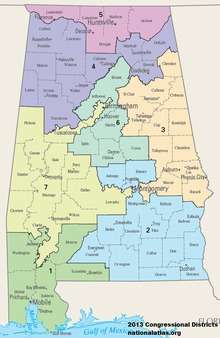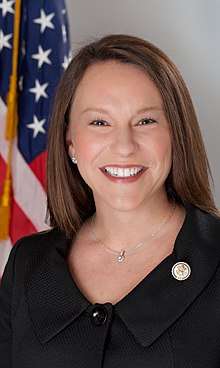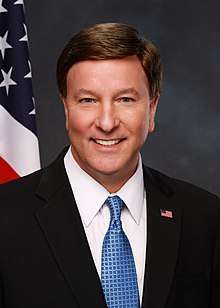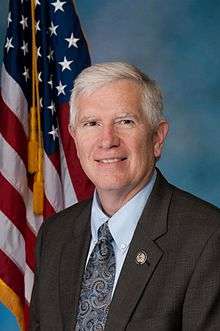Alabama's congressional districts
Alabama is currently divided into seven congressional districts, each represented by a member of the United States House of Representatives. After the 2010 Census, the number of Alabama's seats remained unchanged.

Since the 1973 redistricting following the 1970 United States Census, the U.S. state of Alabama has had seven congressional districts. This is three fewer districts than the historic high of ten congressional districts just prior to the 1930 Census.
Current districts and representatives
The delegation has a total of seven members, including six Republicans and one Democrat.
List of members of the Alabamian United States House delegation, their terms, their district boundaries, and the districts' political ratings according to the CPVI:
| District | Representative | Party | CPVI | Incumbency | District map |
|---|---|---|---|---|---|
| 1st |  |
Republican | R+15 | January 8, 2014 – present | .tif.png) |
| 2nd |  |
Republican | R+16 | January 3, 2011 – present | .tif.png) |
| 3rd |  |
Republican | R+16 | January 3, 2003 – present | .tif.png) |
| 4th |  |
Republican | R+30 | January 3, 1997 – present | .tif.png) |
| 5th |  |
Republican | R+18 | January 3, 2011 – present | .tif.png) |
| 6th |  |
Republican | R+26 | January 3, 2015 – present | .tif.png) |
| 7th |  |
Democratic | D+20 | January 3, 2011 – present | .tif.png) |
Redistricting
The redistricting in 2002 following the 1990 Census marginally strengthened the Democratic position, but has not contributed to any net changes by the parties. The biggest change in 2002 was to the 3rd district, which lost St. Clair County in exchange for part of Montgomery County, including the area around the capitol. The district's black composition rose by 7 percent as a result. However, this did not lead to an unseating of the Republican member.
The Alabama Legislature is in charge of apportionment and redistricting in Alabama. A bipartisan interim committee of 22 representatives (11 from the Alabama House of Representatives, and 11 from the Alabama Senate) is formed to develop a redistricting plan for recommendation to the legislature. The governor has veto power over both the state legislative and congressional plans.
All redistricting plans in recent history have been court-ordered due to a failure on the part of the legislature to enact their own plans. The redistricting plan adopted after the 1990 Census was first proposed by Republicans and ordered into effect by the federal courts. That plan moved black residents out of the 2nd and 6th districts, which had been competitive for Democrats.
The 6th and 7th districts are considered by redistricting watch organizations such as Fair Vote and the National Committee for an Effective Congress to be "irregular" or "gerrymandered".[2]
After a federal trial court rejected a racial gerrymandering claim regarding state house districts, the United States Supreme Court vacated and remanded.[3] The five justice majority found “there is strong, perhaps overwhelming, evidence that race did predominate as a factor”. Because the trial court had wrongly looked for racial gerrymandering at the statewide level the Supreme Court ordered the trial court to instead look at each district individually.[4]
History of congressional delegation

Alabama is typical of most southern states in its pattern, although there are a few interesting deviations. Admitted into the union in 1819, it first appointed members in the 18th United States Congress in 1823. Alabama's growing population coupled with the expansions of the United States House of Representatives meant that by the time the Civil War broke out, Alabama had seven seats - all of which had been dominated by either Democrats or Democratic-Republicans up to that point.
After the civil war, Alabama was subject to the Reconstruction and placed under an effective military control for a period. Typical of this era, freedmen were given the right to vote, and the Republican federal government installed Republican candidates as senators, congressmen and governors. Alabama was no exception. However, by 1874 the Democratic party had re-established itself in Alabama, and a series of redistrictings and then punitive race laws ensured that no Republicans remained congressmen after 1877.
With very little deviation, Southern Democrats (Dixiecrats) remained steadfastly dominant in Alabama until 1965. Over the next 30 years Republicans and Democrats shared representation of Alabama in Congress.
By 1997 the Republicans had come to dominate Alabama's congressional holdings.
Historical and present district boundaries
Table of United States congressional district boundary maps in the State of Alabama, presented chronologically.[5] All redistricting events that took place in Alabama between 1973 and 2013 are shown.
| Year | Statewide map | Birmingham highlight |
|---|---|---|
| 1973–1982 |  |
%2C_1973_%E2%80%93_1982.tif.png) |
| 1983–1992 |  |
%2C_1983_%E2%80%93_1992.tif.png) |
| 1993–2002 |  |
%2C_1993_%E2%80%93_2002.tif.png) |
| 2003–2013 |  |
%2C_2003_%E2%80%93_2013.tif.png) |
| Since 2013 |  |
%2C_since_2013.tif.png) |
References
- "The national atlas". nationalatlas.gov. Archived from the original on February 22, 2014. Retrieved February 2, 2014.
- "Alabama Redistricting 2000". FairVote. Retrieved 2008-05-20.
- Alabama Legislative Black Caucus v. Alabama, 575 U.S. __(2015).
- https://www.brennancenter.org/blog/supreme-court-rejects-mechanical-interpretation-voting-rights-act
- "Digital Boundary Definitions of United States Congressional Districts, 1789–2012". Retrieved October 18, 2014.